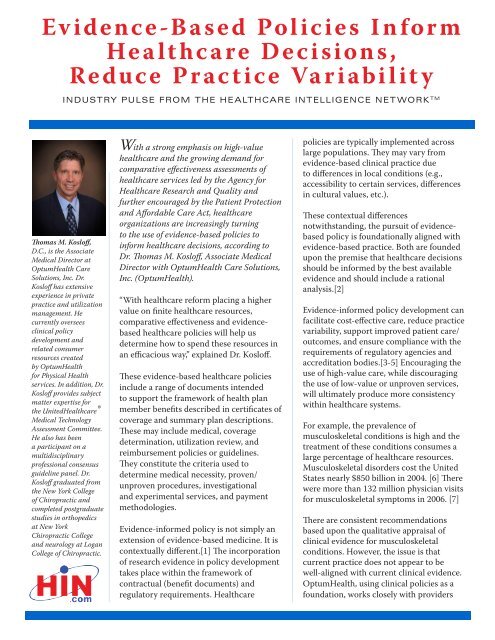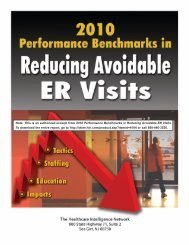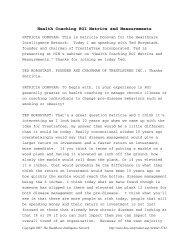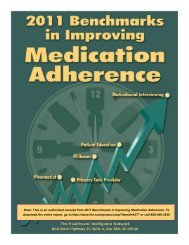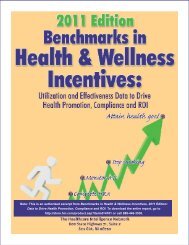Evidence-Based Policies Inform Healthcare Decisions, Reduce ...
Evidence-Based Policies Inform Healthcare Decisions, Reduce ...
Evidence-Based Policies Inform Healthcare Decisions, Reduce ...
Create successful ePaper yourself
Turn your PDF publications into a flip-book with our unique Google optimized e-Paper software.
Ev idence-B a s e d Pol ic ie s I n for m<br />
He a lt hc a re Decision s ,<br />
Re duce Prac t ice Va r iabi l it y<br />
INDUSTRY PULSE FROM THE HEALTHCARE INTELLIGENCE NETWORK TM<br />
Thomas M. Kosloff,<br />
D.C., is the Associate<br />
Medical Director at<br />
OptumHealth Care<br />
Solutions, Inc. Dr.<br />
Kosloff has extensive<br />
experience in private<br />
practice and utilization<br />
management. He<br />
currently oversees<br />
clinical policy<br />
development and<br />
related consumer<br />
resources created<br />
by OptumHealth<br />
for Physical Health<br />
services. In addition, Dr.<br />
Kosloff provides subject<br />
matter expertise for<br />
the United<strong>Healthcare</strong>®<br />
Medical Technology<br />
Assessment Committee.<br />
He also has been<br />
a participant on a<br />
multidisciplinary<br />
professional consensus<br />
guideline panel. Dr.<br />
Kosloff graduated from<br />
the New York College<br />
of Chiropractic and<br />
completed postgraduate<br />
studies in orthopedics<br />
at New York<br />
Chiropractic College<br />
and neurology at Logan<br />
College of Chiropractic.<br />
With a strong emphasis on high-value<br />
healthcare and the growing demand for<br />
comparative effectiveness assessments of<br />
healthcare services led by the Agency for<br />
<strong>Healthcare</strong> Research and Quality and<br />
further encouraged by the Patient Protection<br />
and Affordable Care Act, healthcare<br />
organizations are increasingly turning<br />
to the use of evidence-based policies to<br />
inform healthcare decisions, according to<br />
Dr. Thomas M. Kosloff, Associate Medical<br />
Director with OptumHealth Care Solutions,<br />
Inc. (OptumHealth).<br />
“With healthcare reform placing a higher<br />
value on finite healthcare resources,<br />
comparative effectiveness and evidencebased<br />
healthcare policies will help us<br />
determine how to spend these resources in<br />
an efficacious way,” explained Dr. Kosloff.<br />
These evidence-based healthcare policies<br />
include a range of documents intended<br />
to support the framework of health plan<br />
member benefits described in certificates of<br />
coverage and summary plan descriptions.<br />
These may include medical, coverage<br />
determination, utilization review, and<br />
reimbursement policies or guidelines.<br />
They constitute the criteria used to<br />
determine medical necessity, proven/<br />
unproven procedures, investigational<br />
and experimental services, and payment<br />
methodologies.<br />
<strong>Evidence</strong>-informed policy is not simply an<br />
extension of evidence-based medicine. It is<br />
contextually different.[1] The incorporation<br />
of research evidence in policy development<br />
takes place within the framework of<br />
contractual (benefit documents) and<br />
regulatory requirements. <strong>Healthcare</strong><br />
policies are typically implemented across<br />
large populations. They may vary from<br />
evidence-based clinical practice due<br />
to differences in local conditions (e.g.,<br />
accessibility to certain services, differences<br />
in cultural values, etc.).<br />
These contextual differences<br />
notwithstanding, the pursuit of evidencebased<br />
policy is foundationally aligned with<br />
evidence-based practice. Both are founded<br />
upon the premise that healthcare decisions<br />
should be informed by the best available<br />
evidence and should include a rational<br />
analysis.[2]<br />
<strong>Evidence</strong>-informed policy development can<br />
facilitate cost-effective care, reduce practice<br />
variability, support improved patient care/<br />
outcomes, and ensure compliance with the<br />
requirements of regulatory agencies and<br />
accreditation bodies.[3-5] Encouraging the<br />
use of high-value care, while discouraging<br />
the use of low-value or unproven services,<br />
will ultimately produce more consistency<br />
within healthcare systems.<br />
For example, the prevalence of<br />
musculoskeletal conditions is high and the<br />
treatment of these conditions consumes a<br />
large percentage of healthcare resources.<br />
Musculoskeletal disorders cost the United<br />
States nearly $850 billion in 2004. [6] There<br />
were more than 132 million physician visits<br />
for musculoskeletal symptoms in 2006. [7]<br />
There are consistent recommendations<br />
based upon the qualitative appraisal of<br />
clinical evidence for musculoskeletal<br />
conditions. However, the issue is that<br />
current practice does not appear to be<br />
well-aligned with current clinical evidence.<br />
OptumHealth, using clinical policies as a<br />
foundation, works closely with providers
to try and close the gap between evidence and<br />
practice. These efforts have resulted in reduced<br />
practice variability, improved cost trends for<br />
clients and favorable patient outcomes.<br />
<strong>Evidence</strong>-<strong>Inform</strong>ed Policy Creation<br />
The policies are created by looking at the<br />
research evidence on a given topic. In<br />
particular, OptumHealth forms the basis of<br />
most of its policies by looking at systematic<br />
reviews developed by experts who synthesize<br />
a compilation of research into an interpretable<br />
document.<br />
<strong>Policies</strong> that are based upon systematic evidence<br />
reviews have been shown to be associated<br />
with better outcomes.[8] They allow for large<br />
quantities of information (multiple clinical trials)<br />
to be reduced into useable data that provide for<br />
rational judgments in formulating guidelines<br />
and positions concerning the use of certain<br />
diagnostic tests and treatment strategies.<br />
OptumHealth has developed 70 such policies<br />
to guide healthcare decision-making. Of those<br />
70 policies, 12 to 15 are high-impact, highutilization,<br />
rigorous policies. One to two new<br />
policies are developed each quarter.<br />
“We’ve established a process that mirrors best<br />
practices in clinical guideline development for<br />
high-quality, clinical policies so that health plan<br />
members receive their full benefit and health<br />
plan clients have their resources allocated in a<br />
way that presents value to the organization,” said<br />
Dr. Kosloff.<br />
“New policies can be proposed by various<br />
stakeholders including clients, regulators,<br />
compliance officers, clinical directors, support<br />
clinicians and healthcare providers,” Dr. Kosloff<br />
said.<br />
“Once a policy topic has been proposed, its<br />
necessity is typically established via a business<br />
impact analysis. The analysis seeks to determine<br />
if a policy is required by legislative mandate,<br />
to support a current or planned utilization<br />
management program, or recommended based<br />
upon trends in service requests and/or claims<br />
receipts,” explained Dr. Kosloff. “<strong>Policies</strong> that are<br />
‘required’ receive high priority for development<br />
and implementation. ‘Recommended’ policies<br />
must meet a defined business purpose and have<br />
been operationally mapped through a series of<br />
systematic steps. These policy topics undergo<br />
a structured decision analysis, which results<br />
in their designation as a low, moderate or high<br />
priority for development.”<br />
<strong>Evidence</strong>-<strong>Inform</strong>ed Policy & Practice<br />
Framework<br />
The diagram below (Figure 1) provides a highlevel<br />
conceptual model describing the alignment<br />
of evidence-informed practice and policy. The<br />
model utilizes both the quality and strength<br />
of evidence as the foundation for making<br />
judgments about clinical appropriateness.<br />
Definitive conclusions about the efficacy of a<br />
particular service for a target disorder requires<br />
moderate/high quality evidence.[9] In both the<br />
The <strong>Healthcare</strong> Intelligence Network is the premier advisory service for executives seeking high-quality strategic information on the business of healthcare.<br />
Figure 1<br />
2
practice setting and with healthcare policy, as<br />
the quality and strength of evidence become<br />
weaker along this continuum, decisions about<br />
clinical appropriateness become less confident<br />
(supportable).<br />
Policy Development<br />
To create a policy guideline development team,<br />
organizations have to adequately resource and<br />
train staff to produce evidence-based policies.<br />
Dr. Kosloff recommends prospective authors<br />
work with experienced policy developers in the<br />
process.<br />
<strong>Policies</strong> are created by conducting a literature<br />
search on the intervention being considered.<br />
The policy staff then reviews the background<br />
material and establishes key questions to be<br />
answered around a particular population that<br />
the policy is trying to address.<br />
“The committee would look then at comparatives<br />
for that intervention,” said Dr. Kosloff. “Is it<br />
better than other treatments, or no treatment<br />
or a placebo-treatment The intervention is<br />
evaluated against patient-centered outcomes for<br />
that treatment, such as quality of life, ability to<br />
perform activities of daily living and symptom<br />
severity.”<br />
One of the most challenging aspects of the policy<br />
development process is meeting regulatory and<br />
compliance requirements, Dr. Kosloff warned.<br />
<strong>Policies</strong> have to be developed in a fairly rapid<br />
manner to meet the compliance requirements,<br />
without sacrificing quality.<br />
Another challenge in developing policies is to<br />
make sure that the research findings can be<br />
translated into language that is usable for health<br />
plan members, said Dr. Kosloff.<br />
OptumHealth has developed a definitive<br />
logarithm to translate research evidence findings<br />
into language that is compatible with member<br />
benefit documents to address this challenge.<br />
Once a policy is developed it does need to go<br />
through a vetting process. OptumHealth has a<br />
two-tier committee process that incorporates<br />
academic experts and providers and brings in<br />
the consumer perspective to ensure stakeholder<br />
input.<br />
The final step in policy development is<br />
dissemination. OptumHealth uses a multi-modal<br />
approach to communicate and disseminate<br />
its policies. They are posted on its provider<br />
portal, which is open-access, and summaries<br />
are included in its quarterly newsletter.<br />
OptumHealth also meets with professional<br />
groups on a regular basis to present their policies<br />
and seek feedback that is discipline-specific.<br />
Monitoring and Evaluating Policy<br />
“Once approved and implemented, a policy<br />
requires ongoing monitoring and evaluation to<br />
assess utility and impact,” said Dr. Kosloff.<br />
<br />
<br />
<br />
<br />
Questions to Guide Policy<br />
Monitoring and Evaluation<br />
Is monitoring necessary<br />
What should be measured<br />
Should an impact evaluation<br />
be conducted<br />
How should the impact evaluation<br />
be done<br />
The term monitoring is commonly used to<br />
describe the process of systematically collecting<br />
data to inform policymakers, managers and<br />
other stakeholders whether a new policy is<br />
being implemented in accordance with their<br />
expectations.<br />
“<strong>Policies</strong> need to be audited to ensure that they<br />
are adjudicated properly,” said Dr. Kosloff, “and<br />
from a business model perspective, that they are<br />
effectively achieving the anticipated outcome.”<br />
Indicators are used for evaluative purposes<br />
to judge, for example, if objectives are being<br />
achieved. When the term impact evaluation<br />
is used, this usually implies that there is a<br />
specific attempt to try to determine whether the<br />
observed changes in outcomes can be attributed<br />
to a particular policy.[10]<br />
The <strong>Healthcare</strong> Intelligence Network is the premier advisory service for executives seeking high-quality strategic information on the business of healthcare.<br />
3
OptumHealth revises and updates one to two<br />
policies per quarter. The policies are revised<br />
through monitoring standing queries of<br />
biomedical research on a particular topic.<br />
<strong>Evidence</strong>-<strong>Based</strong> Policy Impacts<br />
“One of the high-impact policies for<br />
OptumHealth is a policy that looks at whether<br />
continuing care is likely to be a benefit for<br />
the patient for any particular service,” said<br />
Dr. Kosloff. “This particular policy is used in<br />
98 percent of all of its denials of services. For<br />
clinicians making a judgement that continuing<br />
care management is unlikely to benefit a patient<br />
and may, in fact, interfere with the patient<br />
accessing more effective care, the policy provides<br />
a strong impact.”<br />
“From a fiscal perspective, the policies can also<br />
assist in helping claims to be adjudicated in the<br />
manner intended,” Dr. Kosloff added.<br />
As we move into a healthcare market that<br />
emphasizes individuals making judgements<br />
about their healthcare with health savings<br />
accounts, evidence-informed policies that are<br />
clearly communicated to clinicians and are easily<br />
understood by patients, will support this patientbased<br />
decision-making process and promote<br />
high-value healthcare.<br />
References:<br />
1.<br />
2.<br />
3.<br />
4.<br />
5.<br />
6.<br />
7.<br />
8.<br />
9.<br />
10.<br />
Black N. <strong>Evidence</strong> based policy: proceed with care. BMJ<br />
2001; 323:275–2799<br />
Sutcliffe S, Court J. <strong>Evidence</strong>-based policymaking:<br />
What is it How does it work What relevance for<br />
developing countries. Overseas Development Institute<br />
Nov. 2005<br />
Oxman AD, Grading the quality of evidence and<br />
strength of recommendations. British Medical Journal<br />
2004; 328:1490-1497<br />
Reilly BM. The essence of EBM. British Medical Journal<br />
2004; 329:991-992<br />
Bronfort G, Haas M, Evans R, Leininger B, Triano J.<br />
Effectiveness of manual therapies: the UK evidence<br />
report. Chiropractic & Osteopathy 2010; 18:3<br />
http://www.chiroandosteo.com/content/pdf/1746-<br />
1340-18-3.pdf<br />
United States Bone and Joint Decade: The Burden of<br />
Musculoskeletal Diseases in the United<br />
States. Rosemont, IL: American Academy of<br />
Orthopaedic Surgeons; 2008.<br />
National Ambulatory Medical Care Survey 1998-2006.<br />
Data obtained from: U.S. Department of Health<br />
and Human Services; Centers for Disease Control and<br />
Prevention; National Center for Health Statistics.<br />
Reilly BM. The essence of EBM. British Medical Journal<br />
2004; 329:991-992<br />
Sutcliffe S, Court J. <strong>Evidence</strong>-based policymaking:<br />
What is it How does it work What relevance<br />
for developing countries. Overseas Development<br />
Institute Nov. 2005<br />
Fretheim A, Oxman AD, Lavis JN, Lewin S. SUPPORT<br />
tools for evidence-informed policymaking in health 18:<br />
planning monitoring and evaluation of policies. Health<br />
Research Policy and Systems 2009, 7(Suppl 1):S18<br />
OptumHealth Contact Info:<br />
Phone:(866) 427-6845<br />
Email: engage@optumhealth.com<br />
Web site: www.optumhealth.com<br />
About OptumHealth<br />
OptumHealth helps individuals navigate the healthcare system, finance their healthcare needs and achieve their health and wellbeing<br />
goals. The company’s personalized health advocacy and engagement programs tap a unique combination of capabilities that<br />
encompass public sector solutions, care solutions, behavioral solutions, specialty benefits and financial services. Serving nearly 60<br />
million people, OptumHealth is one of the nation’s largest health and wellness businesses, and is a UnitedHealth Group® (NYSE: UNH)<br />
company. More information about OptumHealth can be found at www.optumhealth.com.<br />
©2010, <strong>Healthcare</strong> Intelligence Network®. All Rights Reserved.<br />
The <strong>Healthcare</strong> Intelligence Network is the premier advisory service for executives seeking high-quality strategic information on the business of healthcare.<br />
4


